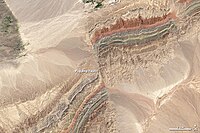
Photo from wikipedia
Abstract Fractures at different scales are an integral component of shallow crustal deformation associated with the progressive evolution of a fold-thrust belt (FTB). We characterize the evolution of fractures from… Click to show full abstract
Abstract Fractures at different scales are an integral component of shallow crustal deformation associated with the progressive evolution of a fold-thrust belt (FTB). We characterize the evolution of fractures from the Buxa dolomite of the Main Boundary thrust (MBT) sheet in the frontal segment of the Arunachal Lesser Himalayan FTB. Regionally, the MBT sheet forms a fault-bend antiform. Based on unfolding of strata, early formed low- and moderate-angle fractures are interpreted to be pre-folding layer-parallel shortening structures, while the dominant late-stage high-angle fractures are inferred to have formed synchronous to folding, tracking the progressive deformation of the orogenic wedge. The high-angle fracture set is the dominant one at both outcrop and microscopic scales, forming ∼44% and ∼45% of the total number of fractures, respectively. Microfracture analysis indicates that ∼41% of the high-angle fractures, ∼22% of the moderate-angle fractures and ∼10% of the low-angle fractures form veins, respectively. Cumulative plots of fracture spacing values collected from outcrops and under the microscope reveal that this parameter is best described by power-law distributions that indicate scale-independence of fracture spacing. However, the coefficients of variation (Cv) of spacing of these high-angle fractures reflect scale-dependent clustering.
Journal Title: Journal of Structural Geology
Year Published: 2019
Link to full text (if available)
Share on Social Media: Sign Up to like & get
recommendations!